The RH Herald on Dec. 1, 1887 reported – “The Library Board has elected two new members: J.G. Anderson and W. Dillingham to replace Rev. W.B. Jennings and C.V. Simons, both whom have moved away.”
The Herald reported on Feb. 24, 1932 – “Rock Hill’s Public Library has had its formal opening of its new home on Oakland Avenue.”
City Directories and History: 1946 – Rock Hill Public Library, 1963 – Same
The SC Gazetteer stated: “One of the most popular institutions in Rock Hill is the public library, which has been very appropriately named ‘The People’s Pet.” This institution of itself is an ornament to the town. The Library Association was founded in June 1884, and since that time has grown in influence and importance each year. There are now over 150 members who pay annual dues of two dollars each. Shortly after the organization of the Association the cornerstone of the library building was laid. The cost of the building was about $3,000. The officers of the Library Association are as follows: President, the Rev. J.S. White; vice president, the Rev. J.Q. Adams; directors, J.J. Hull, J.R. London, W.J. Roddey, D. Hutchinson, and J.G. Andrews.
The ladies have a very great pride in the library, and each week donations are made to the supply of books and magazines of the institution. Donations are also made of a more substantial nature, and every now and then money is given to the library. It is the repository for public documents for the Fifth Congressional District, and valuable public papers are sent here almost every week. At the present time it has over 1,500 volumes of judiciously selected books. All the periodicals of any importance can be always found here, and every paper of any note is always on file here. The News and Courier can be found here at all times.” Reprinted from South Carolina in the 1880s: A Gazetteer by J.H. Moore, Sandlapper Publishing Company – 1989
——————-
History of the York County Library, 1884-1984 – Prepared by Ruth Byers and Anne Harper with advice from William B. White, Jr. This booklet was published in 1984 to celebrate the centennial of the library. Below is a summary of notes from the booklet.

Images courtesy of the Turner Collection – 2012. Note the construction of the Post Office on Main Street.
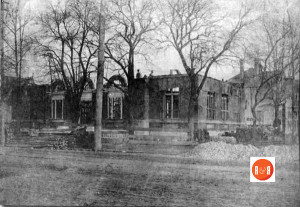
The Library Association was organized in 1884 by Rev. James S. White. Within a few months, a reading room was established in the front part of Holler’s Hall on the corner of Main and Caldwell Streets. The group contracted with Rev. White for space in a new two-story building to be constructed on the south side of Main Street. The Library had the first floor. The cornerstone was laid on August 28, 1884 and the space was occupied in November of that year. The building was located on the corner of Elk Avenue and East Main Street. Later occupants included the Peoples National Bank and the Periwinkle Tea Room. This building was razed in 1952, and the bricks salvaged from the demolition of the White Building were used to build the Goodwin Thomas home on Oakwood Avenue.
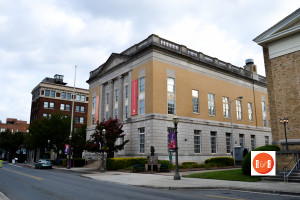
In 2015 the Gettys Center occupies the identical space once reserved for the YC Post Office and later library.
After Rev. White died in 1891, support for the library dwindled and it ceased to operate around 1900. Another effort to begin a library was undertaken about 1904. A group sought funds from the Carnegie Fund, but was unsuccessful as Carnegie had recently funded the library building at Winthrop College.
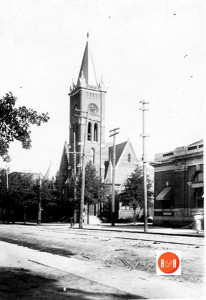
Originally this building stood on Main Street next to the third location of St. John’s Methodist Church and was moved to the current location. Courtesy AFLLC
Around 1910, the Women’s Clubs helped to form a new Library Association. The small library was housed in several locations in the downtown area. In 1916, a fire in the Ratterree Building on the corner of Main Street and Trade Street damaged the library room.
All of the early efforts were undertaken by volunteer groups with no tax support. In 1923, the first public support for a library came in the form of a tax levied within the Rock Hill School District and designated for library support. By 1924, a lot was purchased on South Oakland Avenue from St. John’s Methodist Church. In 1930, the old Post Office building was purchased.
This building, constructed in 1905, was slated to be replaced by a new Federal Building/Post Office (now the Gettys Center). In the summer of 1931, the old post office was moved from Main Street to the Oakland Avenue property. This move was accomplished using mules and rolling the building on logs. G.O. Oates shared in 2016, that his great uncle, Ike Oates of Rock Hill helped move the library building. He stated, “All I know, is he was responsible for bring fresh mules to town, they rolled the building on logs. He said some days they wouldn’t move the building maybe 3 inches.” The new library was opened in this building in February 1932. A major renovation and addition in 1956-57 added a children’s library and additional space. [After this booklet was published, the main Library was moved to a new building on East Black Street next to the City Hall.]
The early libraries in Rock Hill were open to whites only. For the African-American population, the Palmetto Library was the only facility available. A library was housed in a building at Friendship College. In 1933, Rev. W. M. Parker campaigned for a public library for African-Americans. In 1936, the Palmetto Branch Library was created. It was initially housed in the Emmett Scott School building. In December 1944, the Palmetto Library was moved to a house on South Trade Street with Mrs. Annie Cloud as Librarian. It remained there until July 1968, when the building was demolished as part of the urban renewal program.
——————
Moved from its original location at the corner of East Main Street and Caldwell in 1931, this building was rolled on logs using mule power to move it to the current location where it was re-instituted as the Rock Hill Library. Note the Sanborn Insurance Map attached does not show any building next to Saint John’s Methodist Church in 1926. Also see The Rock Hill Post Office link. Note this library was not open to African American citizens who were required to use the Palmetto Library on South Trade Street, pictured below.
The Rock Hill Record reported June 17, 1904 contained an article on the construction of the new post office. It included a rendering of the new Post Office and stated, “that construction will begin at an early data. The supervising architect is James Knox Taylor.” [The SC Architects: 1885-1935 Wells & Dalton, 1992 attributed this building to James Knox Taylor in 1905 at a cost of $32,500.]
The Herald reported on July 29, 1925 – “That A. Rembert Barrett, Postmaster is seeking an addition to the post office due to strong business.”

This 1895 image shows the original location (lt building) of the library on East Main Street. Courtesy of the YC Library
The SC Architects: 1885 – 1935, Wells and Dalton, 1992 – Reported, “A.D. Gilchrist designed alterations to the building when it was moved to Oakland Avenue in 1931 at a cost of $12,400.”
The Herald reported on April 28, 1931 – “With the breaking of ground for excavation of the basement, work has started today on the library site on Oakland Avenue adjacent to the property of St. John’s Methodist Church. Excavation must be completed before the present post office building can be moved to the site. J.M. Porter has the contract for this work.”
The Herald reported on May 6, 1931 – “The London Printery is the successful bidder on the contract for the furniture for the new library. The furniture is from the Globe – Wernicke Company. The cost is $3,482. and includes tables, chairs, desks, card catalogs and shelving. A.D. Gilchrist, local architect, had charge of the bids.”
The Herald reported on June 1, 1931 – “Rollers are being put under the former Post Office building on Main Street today in preparation for moving the structure to St. John’s Court, where it will be used as a public library. The moving is being done by D.B. Stearns. The post office is now in temporary quarters on Hampton Street.”
The Herald reported on June 4, 1931 – “Preparations for actually rolling the former post office building to St. John’s Court are making fast progress under the direction of the contractor, D.B. Stearns (Stearnes).”
The Herald reported on July 24, 1931 – “Today the post office building was being placed on its foundation at the new site on the corner of Oakland Ave., and St. John’s Court where it will be used as a public library. The structure had been rolled from its former site on Main Street, across Oakland to a position directly over the foundation. Members of the library commission stated today that it is thought the building will be in use by November.”
The Herald reported on Jan. 31, 1932 – “Books and furniture were being moved today to the new public library from the old location on the 2nd floor of the building at the corner of Main and Hampton Streets.”
Click on the More Information > link found below the picture column for additional data or pictures. As well as YC History #1, YC History #2
Click HOME to return to the numbered site tour of Rock Hill’s downtown.
Stay Connected
Explore history, houses, and stories across S.C. Your membership provides you with updates on regional topics, information on historic research, preservation, and monthly feature articles. But remember R&R wants to hear from you and assist in preserving your own family genealogy and memorabilia.
Visit the Southern Queries – Forum to receive assistance in answering questions, discuss genealogy, and enjoy exploring preservation topics with other members. Also listed are several history and genealogical researchers for hire.
User comments welcome — post at the bottom of this page.
Please enjoy this structure and all those listed in Roots and Recall. But remember each is private property. So view them from a distance or from a public area such as the sidewalk or public road.
Do you have information to share and preserve? Family, school, church, or other older photos and stories are welcome. Send them digitally through the “Share Your Story” link, so they too might be posted on Roots and Recall.
User comments always welcome - please post at the bottom of this page.
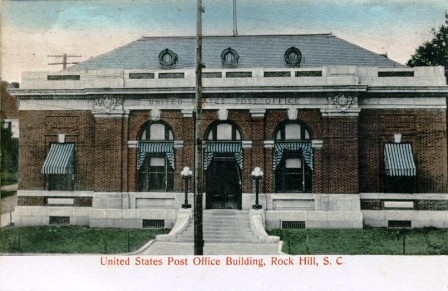
 Click on image to pan and zoom.
Click on image to pan and zoom.
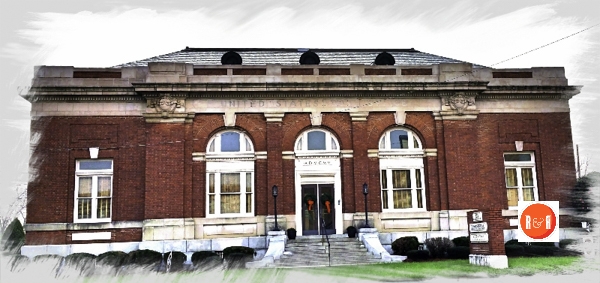



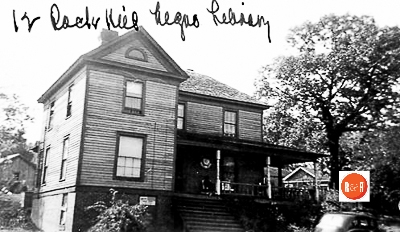
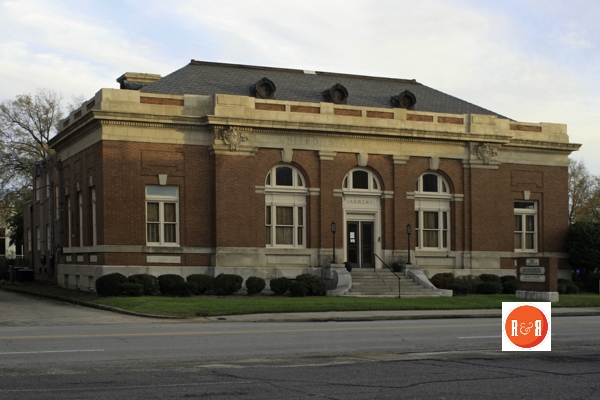







Great article! The photo with the Baptist church, library, and St. John’s is an interesting one. The Baptist church building still sits at this location. The library building was moved, as explained in this article. St. John’s is at another location, and the St. John’s building shown has been moved or demolished. I don’t see the bell tower in this photos elsewhere in the City. Was part of it repurposed?
Thank you for your input. Saint John’s on the corner of Main and Caldwell was demolished to make room for the new Citizens Bank. I have no knowledge of what happened to the bell. Please let me know you received this message!
Wade@R&R.com
Thanks for the reply Wade! There are some beautiful bell towers and churches in Rock Hill. I looked at all of them on Google, and they are all unique!
To bad you didn’t do it on R&R, much nicer view of local history and local churches across S.C.!